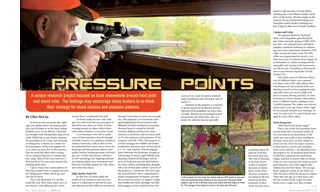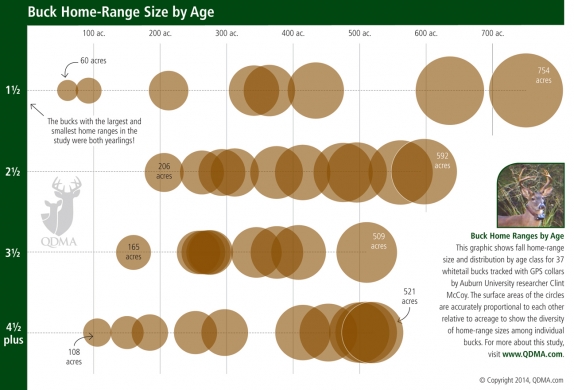In the October/November 2014 issue of Quality Whitetails, the magazine received by QDMA members, deer researcher Clint McCoy shared what he learned about the effects of hunting pressure on buck movements. For his graduate-level research, he tracked the fine-scale movements of 37 different bucks wearing GPS collars on a 6,400-acre hunting site in South Carolina. Because habitat quality is extremely high on the site, Clint predicted he would find relatively small home-range sizes since bucks don’t need to move far to find plenty of food, cover and breeding opportunities. His prediction was accurate.
The graph above displays the relative fall home-range size by age class for all 37 bucks. While the average home-range size was 350 acres, some interesting observations emerged when age was considered.
“Our two smallest home ranges were yearling bucks at 60 and 90 acres. Our two largest home ranges of 754 and 640 acres were also yearling bucks!” said Clint. “Age apparently did not play a role in determining the size of a buck’s home range in our study, and as previous studies have documented, buck movements are largely driven by their own ‘personalities’ – some bucks tend to cover large areas while others are content to stay close to home. To further illustrate that point, take two of our 4½-year-old bucks – one had a home range of 521 acres, the other only 108 acres!”
Considered separately, each age class averaged between 300 and 400 acres for individual home-range size, which many hunters would consider to be relatively small. The likely explanation is in the habitat on the study site. Actively managed for wildlife and timber production, most areas are burned on a 2- to 4-year rotation. Combined
with thinning of various-aged pine stands, this ensures substantial production of natural forage and browse. Also, roughly 300 acres of food plots are planted annually (about 5 percent of the property). Bucks do not need to travel far to find everything they need throughout the year. This is a useful lesson for hunters, especially small-property hunters: To shrink the home ranges of bucks and hold them longer on your hunting land, provide high-quality cover and forage across every season.

Clint’s article in Quality Whitetails, titled “Pressure Points,” focused on the interaction between these bucks and the hunters who were pursuing them. If you’re not a QDMA member, you can start receiving Quality Whitetails and more great articles like Clint’s when you become a QDMA member.
